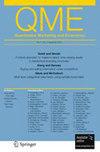价格促销的动态效应:实地证据、消费者搜索和供应方影响
IF 1.1
4区 管理学
Q3 BUSINESS
引用次数: 19
摘要
本文通过对智利一家大型零售商的10家超市17个类别170种产品的促销深度进行大规模实地实验,研究了零售环境中价格促销的动态影响。在实验的干预阶段,接受治疗的客户暴露于深度折扣(约30%),而对照客户暴露于浅折扣(约10%)。在随后的衡量阶段,促销计划保持各组折扣水平不变。我们发现,尽管面临着同样的促销交易,但接受治疗的客户购买促销商品的可能性比对照组高22.4%。引人注目的是,价格促销的动态效应(当促销深度在不同条件下相等时)的大小是干预阶段提供浅折扣与深折扣所引起的促销效应的61%。这一结果对其他同时发生的动力是稳健的,包括消费者的囤积行为和国家依赖。我们使用实验变化和历史促销活动来为消费者寻找交易的需求侧模型和企业争夺这些消费者的供应侧模型提供信息。我们发现,小型制造商可以通过利用促销来诱导未来的考虑,从而从提高促销敏感性中受益。然而,当单位利润率高时,晋升敏感性的提高会导致激烈的竞争,使所有公司的境况都更糟。本文章由计算机程序翻译,如有差异,请以英文原文为准。
Dynamic effects of price promotions: field evidence, consumer search, and supply-side implications
This paper investigates the dynamic effects of price promotions in a retail setting through the use of a large-scale field experiment varying the promotion depths of 170 products across 17 categories in 10 supermarkets of a major retailer in Chile. In the intervention phase of the experiment, treated customers were exposed to deep discounts (approximately 30%), whereas control customers were exposed to shallow discounts (approximately 10%). In the subsequent measurement phase, the promotion schedule held discount levels constant across groups. We find that treated customers were 22.4% more likely to buy promoted items than their control counterparts, despite facing the same promotional deals. Strikingly, the magnitude of the dynamic effects of price promotions (when promotional depths are equal across conditions) is 61% of the promotional effects induced by offering shallow vs. deep discounts during the intervention phase. The result is robust to other concurrent dynamic forces, including consumer stockpiling behavior and state dependence. We use the experimental variation and historical promotional activities to inform a demand-side model in which consumers search for deals, and a supply-side model in which firms compete for those consumers. We find that small manufacturers can benefit from heightened promotion sensitivity by using promotions to induce future consideration. However, when unit margins are high, heightened promotion sensitivity leads to fierce competition, making all firms worse off.
求助全文
通过发布文献求助,成功后即可免费获取论文全文。
去求助
来源期刊

Qme-Quantitative Marketing and Economics
Multiple-
CiteScore
2.30
自引率
10.50%
发文量
13
期刊介绍:
Quantitative Marketing and Economics (QME) publishes research in the intersection of Marketing, Economics and Statistics. Our focus is on important applied problems of relevance to marketing using a quantitative approach. We define marketing broadly as the study of the interface between firms, competitors and consumers. This includes but is not limited to consumer preferences, consumer demand and decision-making, strategic interaction of firms, pricing, promotion, targeting, product design/positioning, and channel issues. We embrace a wide variety of research methods including applied economic theory, econometrics and statistical methods. Empirical research using primary, secondary or experimental data is also encouraged. Officially cited as: Quant Mark Econ
 求助内容:
求助内容: 应助结果提醒方式:
应助结果提醒方式:


